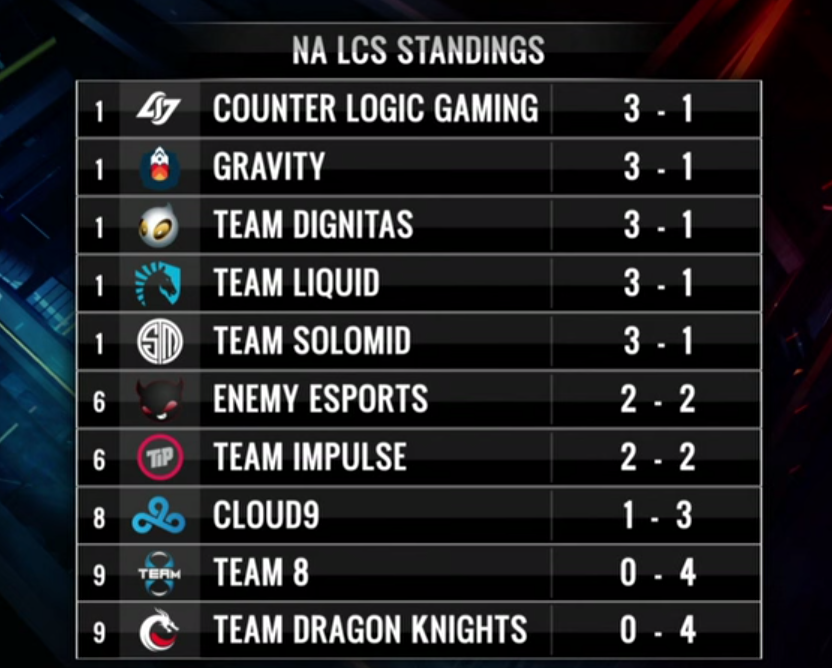The LCS standings are a crucial aspect of the League of Legends competitive scene, offering insights into team performance and overall rankings. As the North American League of Legends Championship Series (LCS) progresses, fans and analysts alike eagerly track the standings to gauge which teams are excelling and which ones may need to step up their game.
In this article, we will delve into the intricacies of the LCS standings, exploring how they are determined, the implications for teams and players, and what the statistics reveal about the current competitive landscape. Whether you're a die-hard fan or new to the scene, understanding the standings is essential for appreciating the depth of competition within the LCS.
We'll cover everything from key metrics that influence standings to historical context, providing a comprehensive overview for readers. Let’s get started with our detailed exploration of the LCS standings!
Table of Contents
- What are LCS Standings?
- How are the Standings Determined?
- Key Metrics in LCS Standings
- Historical Context of LCS Standings
- Impact of Standings on Teams
- The Role of Fans in LCS Standings
- Recent Trends in LCS Standings
- Future of LCS Standings
What are LCS Standings?
The LCS standings represent the ranking of professional League of Legends teams in the North American region. These standings are updated regularly throughout the season, reflecting each team's performance in matches played against other teams. The standings are crucial for determining playoff eligibility and seeding, ultimately impacting which teams have the chance to compete for the championship title.
How are the Standings Determined?
Standings in the LCS are determined based on a series of criteria:
- Match Wins and Losses: The primary factor is the number of wins and losses a team has accumulated throughout the season. Each win contributes positively, while each loss detracts from the overall standing.
- Game Differential: This metric measures the overall performance in terms of games won versus games lost, providing a clearer picture of a team's dominance or struggles.
- Head-to-Head Records: In cases where teams have identical records, head-to-head match results are used as a tiebreaker.
- Strength of Schedule: Some leagues may consider the difficulty of opponents faced throughout the season, which can influence standings indirectly.
Key Metrics in LCS Standings
Several key metrics are essential for understanding the LCS standings:
- Win Rate: This percentage indicates how many games a team has won compared to the total games played. A higher win rate signifies stronger performance.
- Kill-Death-Assist (KDA) Ratio: This statistic reflects a player's ability to contribute positively in games, combining kills, deaths, and assists into a single number.
- Gold Difference at 15 Minutes: This metric shows how well a team is performing in the early game, which is crucial for setting the pace for the rest of the match.
Historical Context of LCS Standings
The history of LCS standings offers valuable insights into the evolution of the competitive scene in North America. Teams like Team SoloMid (TSM) and Cloud9 have historically dominated the standings, showcasing the competitive rivalries that have developed over the years. Analyzing past standings can help fans understand trends and shifts in team performance.
Impact of Standings on Teams
The standings significantly impact a team's strategy and morale:
- Playoff Qualification: The top teams in the standings qualify for playoffs, which are critical for competing for the championship.
- Sponsorship and Revenue: Higher rankings attract better sponsorship deals and increase revenue potential for organizations.
- Player Retention: Teams that consistently perform well in the standings may have an easier time retaining top talent and attracting new players.
The Role of Fans in LCS Standings
Fans play a crucial role in the LCS ecosystem. Their support can influence team performance and morale. Additionally, fan engagement can lead to increased viewership, which impacts revenue and investment in the scene. Teams often look to their fanbase for feedback and support as they navigate the competitive landscape.
Recent Trends in LCS Standings
As the LCS evolves, several recent trends have emerged:
- Increased Parity: More teams are showing competitive performance, leading to tighter standings and unpredictability.
- Emergence of New Talent: The influx of new players and teams has shifted traditional power dynamics.
- International Performance: Teams are increasingly focusing on international play, aiming to improve their standings globally.
Future of LCS Standings
The future of LCS standings is likely to be shaped by several factors:
- Franchise Model: With the franchise model in place, teams are incentivized to invest in long-term success to maintain their standing.
- Technological Advancements: Data analytics and performance tracking tools will continue to evolve, providing teams with deeper insights into their standings.
- Community Engagement: Increased focus on fan engagement and community building will play a significant role in shaping team dynamics and standings.
Conclusion
In summary, the LCS standings serve as a vital indicator of team performance and competitive dynamics within the League of Legends ecosystem. Understanding how these standings are determined, their impact on teams, and the historical context can enrich your appreciation of the game. Whether you're a fan or a player, staying informed about the standings is crucial for engaging with the competitive scene.
We encourage you to share your thoughts in the comments below, explore other articles on our site, and stay up to date with the latest developments in the LCS standings!
Closing Thoughts
Thank you for reading! We hope this article has provided you with valuable insights into the LCS standings. We look forward to welcoming you back to our site for more in-depth coverage of your favorite esports topics!
![Surrender at 20 This Week in Esports [JULY 20TH JULY 26TH]](https://4.bp.blogspot.com/-IuBWhYteTR8/VbWZkEqepLI/AAAAAAAAAi4/o5ckaoSXKt0/s1600/na%2Bbracket.jpg)



